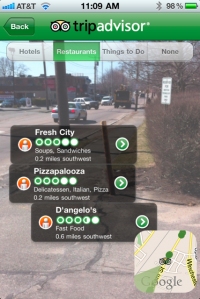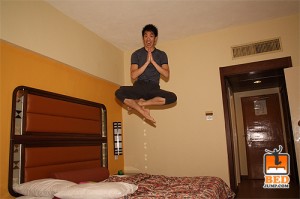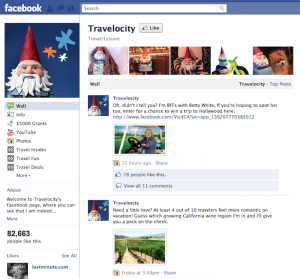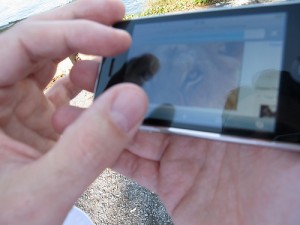May 2011 Mobile & Social Media Roundup
![]() by Nicole Petrak, ATTA Special Projects and Assistant Editor to AdventureTravelNews
by Nicole Petrak, ATTA Special Projects and Assistant Editor to AdventureTravelNews
Augmented Reality

TripAdvisor, who already has 5 million unique monthly mobile users, has announced the launch of a virtual tours iPhone/iPad app that uses augmented reality technology. Users can “walk” through neighborhoods at their desired destination and view businesses and locations superimposed over Google Street View, along with access to the 40 million + consumers travel reviews from the website as well as a “Near Me Now” function, a flight comparison tool, traveler forums, and photo content from other users.
In using the augmented reality capabilities of the iPhone/iPad, TripAdvisor joins the ranks of Lonely Planet, the Museum of London, and tourism boards such as Tuscany, Dublin, Netherlands, Holland and Vienna. Some resorts and tour companies have been taking up the feature as well - but before you decide to throw your hat in the ring, take a look at a recently released study, the 2011 Portrait of American Travelers by YPartnership.
The company, a brand strategy and consumer insights firm focused on travel and leisure, undertook a survey revealing that only 7% of active travelers currently have online access to a tablet device such as the iPad. However, of those that do use them, 40% are primarily searching for nearby restaurants and shops, shopping for hotel and airfare, and checking flight information. About a third of them book travel on their tablet, and roughly 25% of them have used their device as a GPS, viewed virtual visitors’ guides, and shared feedback and photos while traveling. Twenty percent have “checked in” from their tablet to let others know where they are.
For more background on augmented reality applications, take a look at CNN Go’s Top 10 augmented reality travel apps
The takeaway from this is that its probably not necessary to spend a lot of time or money developing a tablet application for your company just yet despite all the buzz. While you should keep an eye on these numbers - as well as the ways the devices are being used - more of your consumers are currently using smart phones to access content, a trend likely to hit saturation in the market long before tablet use. And previous advice from ATTA’s Director of Online Strategies Jason Reckers still holds true: if nothing else, make sure your web content is optimized to be viewed across multiple platforms.
Let’s transition to social media. In the increasingly social - and opinionated - world of consumer behavior, getting customers to interact with your brand in front of their friends and the worldwide web is the “sweet spot." However, figuring out how to do this well can be tricky.
Social Media in Travel

Louise Woodward of PR and social media company Umpf put together a list for Tnooz of the top 15 social media campaigns in travel, ranging from Facebook games (snowboarding from Japan Tourism and pig catapulting from Manchester Airport), to “Klout Klubs” that give amenity perks to customers (Las Vegas Palm Hotel) or free flights (Virgin America) for sharing influencing experiences on social media.
KLM essentially “web-stalked” several of its passengers in an airport, discovering their preferences and habits via their social media profiles, and presented them personalized gifts for their trips upon boarding, resulting in a nice (if a little creepy) public relations video. HotelsbyCity.net has created an Internet craze with their BedJump blog, and even Stella Artois beer company has participated in the travel arena, with an app that allows users to hold their phone up in the street and see which bars serve Stella beer (they can also search by country and city, rate the bars and call a taxi - a useful tool in a new place). Woodward’s Top 15 list is worth a look for more clever and creative travel social media campaigns, as well as a link to the best of non-travel specific campaigns for 2010.
Brand Engagement on Facebook

For those highly focused on Facebook for interacting with customers, Mashable’s recent stats article on HOW TO: Improve Engagement on Your Brand’s Facebook Page, based on a study by Buddy Media, is pretty fascinating.
It found most businesses are missing their customers by posting on the wrong days and times - during the work week. However, Facebook peak usage occurs before and after work and late at night: 7am, 5pm, and 11 pm respectively (EST). And users are interested in different types of posts on different days of the week - the article provides a full list and notes that Travel & Hospitality posts do best on Thursdays and Fridays, when people’s attention is moving towards their free time.
Additionally, short posts (80 characters or less - not even a tweet!) get almost a third more reaction than longer posts - but, don’t shorten the URL because posts with full-length URLs get three times as much engagement - people want to know where they’re going.
Some other key tips:
- Outright asking for likes and comments is effective
- If you’re seeking answers, use a simple question at the end of the post, where it gets 15% more engagement than if the question is at the beginning or middle
- Users don’t like “why” questions as much as “what” questions
And in case you’re still wondering how important it is to buy into the most current forms of online exposure, a note about your future travelers...
Global Study of Youth (College Student) Usage of Media
According to a new study of global college students, the youth demographic of the world is surprisingly similar in how they use media - and that is constantly.

The International Center for Media & the Public Affairs (ICMPA) and the Salzburg Academy on Media & Global Change asked 1,000 students in ten countries on five continents to “unplug” and from using all media for a full day. They were then asked to report back - together, the students from a dozen universities wrote close almost 500,000 words –the same number of words as Leo Tolstoy’s War and Peace.
The results were startling - this demographic appears to be literally addicted to media, showing signs of cravings, depression and anxiety without it. Tools for accessing media, such as smartphones, are seen as extensions of themselves, and social networking is not considered a habit but an essential way they construct and manage their social relationships and identities. Inadvertently the study also bears insight into how marketing to this generation is going to be different - here are some key points gleaned from the 15 major themes found in the study:
- Email is seen as a tool geared towards older people and concentrated around work - not for entertainment or information
- TV is a format mainly for escapism - the participants reported watching it only for relaxation and without following the same shows religiously
- “News” means anything that just occurred, be it hard news or friends’ announcements
- Because they are constantly connected on a variety of platforms, they are inundated with information and therefore rarely seek out actual news
- They prefer content in short summaries (think of a 140 character Twitter update); for detailed stories, they would rather see strings of short updates than click on and read a longer story
- They stay on top of major news events by reading headlines and short updates on sites like Facebook and Twitter; they rarely read longer, traditional stories unless they are personally relevant.
